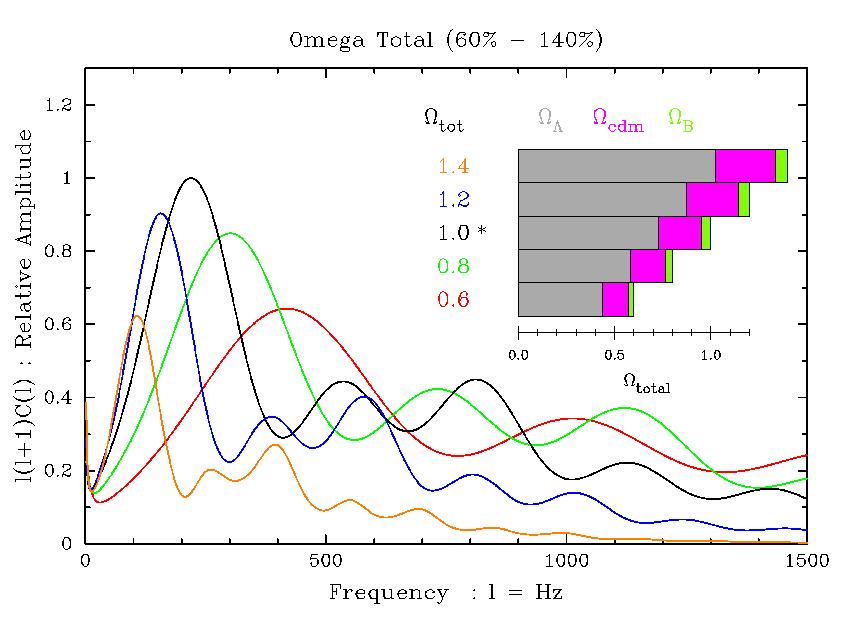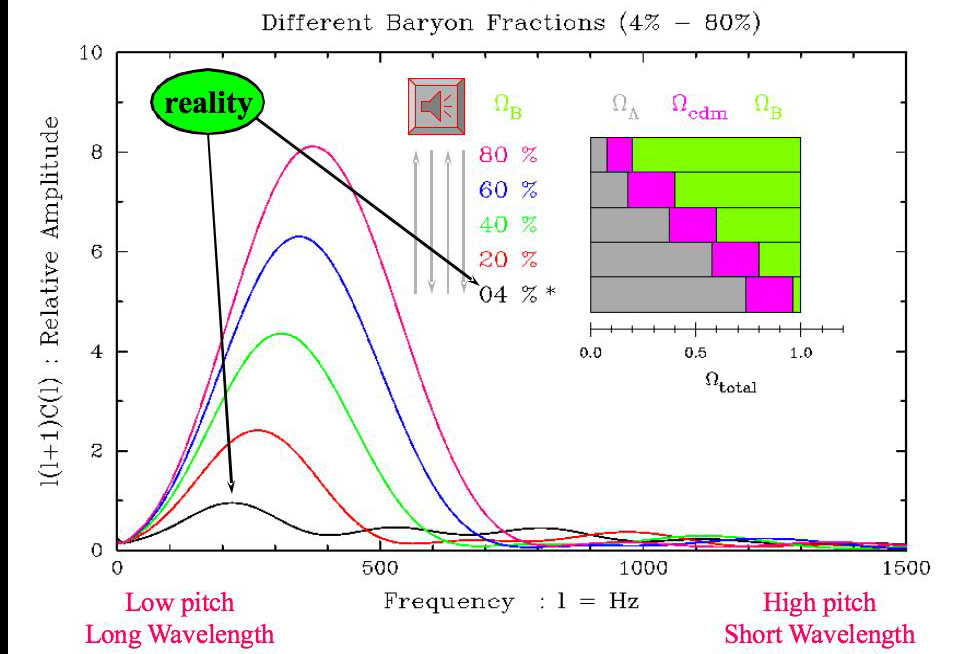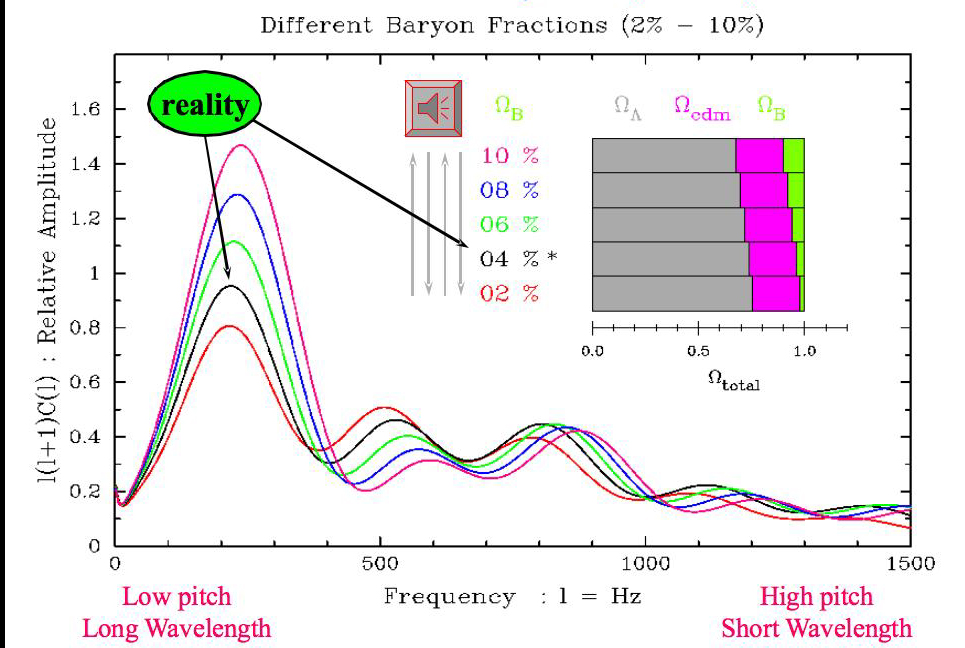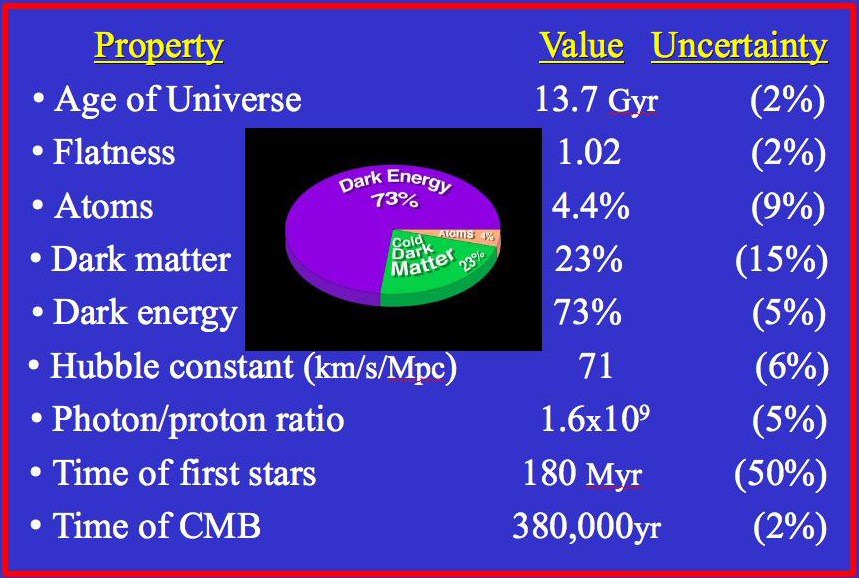
Click for sound sequence
Strike a wineglass and a teacup, and instantly we recognize the difference. An amusing game is to see if you can, without looking, tell what an object is by listening to the sound it makes when a friend gently taps it. Our experience and "common sense" gives us quite a skill at this game, although a physicist trained in acoustics might do even better if they recorded the sound spectrum and used that to help deduce the object's nature. Sound, then, carries a great deal of information about the structure of the vibrating object — its size, shape, stiffness and so on; it is a little like a fingerprint, with an almost unique match to the object.
So too with the Universe; its sound can tell us about its structure and composition. This is why the CMB sound spectrum is so important to astronomers, not to "listen" to the sound, but to use it to measure the Universe's properties!
The science of cosmic acoustic diagnostics has developed greatly in the past few years, and will continue to become more refined in response to ever better data. The next slides show two classic examples. The first shows how the overall pitch of the cosmic sound depends on the density of the Universe: denser universes have deeper voices. The second shows how the higher harmonics depend on the amount of atomic matter present: universes with more atomic matter have a hissier voice.
The diagram below shows the sound spectra for 5 different universes, each with a different overall density, ranging from 1.4 times "critical density" to 0.6 times "critical density". The total density and fractional compositions are shown by the bar chart, and the sound spectra color coded for the different universes.
Click the image to get more details, and click the black button to hear the sequence, starting with the least dense universe.

|
Click for sound sequence |
Clearly, denser universe's have deeper voices (for reasons explained in the link from the image). If we now compare the real Universe's true sound – measured from the CMB – with the sounds in the sequence, we find the one with 1.0 times the critical density (the black curve) is the best match.
As you may know, the current composition of the Universe is dominated by three different components: dark energy, dark matter, and atomic matter. In these figures they are shown as grey, purple and green, in the bar charts. As with the example above, which varied the total cosmic density, we can also vary the fractional composition. In our second example, we're changing the atomic matter content, while keeping the total density fixed (at the critical value, found in the previous example).
As before, click the image to get more details, and click the green button to hear the sequence, which starts with the atomic-poor universe. The total range is from 4% to 80% atomic matter.

|
Click for sound sequence |
In this case, the atomic-rich universes have a much stronger fundamental tone compared to the higher harmonics, and it is shifted up in pitch a little compared to the atomic-poor universes. In this example, matching to the true sound – measured from the CMB – singles out the most atomic-poor universe. So let's zero in on that and make a new sequence that spans from just 2% to 10% atomic matter:

|
Click for sound sequence |
In these two examples, you can see the primary way in which cosmologists adjust their model Universes: the relative amount of the three primary ingredients (atoms, cold dark matter, and dark energy - green/purple/gray); and the total content (Ωtot = Ωde + Ωdm + Ωat ). Notice, also, how the sound spectra are much more discriminating than our ears — a very obvious difference in the spectra which arises from a factor 5 difference in atomic content (2% to 10%), is actually quite difficult for us to hear.
Please also reflect on this result: just 4% of the content of the Universe is stuff we are familiar with – all the planets, stars, galaxies, gas clouds, and people in the Universe make up just 4% ! What the other 96% is we'll get to in just a moment.
A final note about the terms used: baryonic matter is the scientist's preferred choice. This refers to anything which is made of protons and/or neutrons (and their associated electrons), and includes both ionized as well as neutral atomic matter – which is why the term is preferred to simply "atomic matter" – recall, there were no fully formed atoms before 400,000 years. The other important reason for specifying baryonic (or atomic) matter, is to distinguish it from dark matter, which is radically different, as we shall see.
The examples of density and atomic content are just two of many properties that affect the CMB sound spectrum. By adjusting many such properties in a computer model which is designed to match the observed sound spectrum, one can effectively measure all these properties. In practice, about 5 astronomical datasets are included in this matching game, and the closest match is called "The Concordance Model" — since it agrees best with all the datasets. The next slide shows some of the properties of the concordance model. These are our best estimates of the Universe's properties, and include its age, geometry, composition, dynamic state, history, and likely future.

|
This is a remarkable table. For thousands of years, people have imagined how their world came into being, with hundreds of different versions of that story. Now we know. Far into the future, the few decades in which we now live will be recalled as a time when people first began to understand creation's true story. The numbers in the table are like early measurements of planetary orbits; rough at first and always to be refined. But never again will we wonder if planets are holes in crystal spheres which spin around the Earth.
Perhaps most delightful of all, is that such wild and remote times are actually accessible to our little brains which were, after all, designed for a quite different purpose than figuring out how the Universe began. Even so, without science's empirical input steering a new path, our imagination – on its own – never once came near to the correct story, being tethered so close to home.